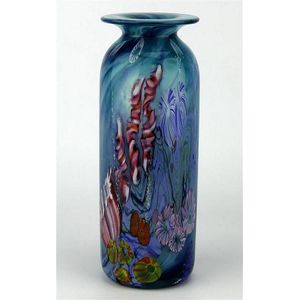Shelley Lustre Vase with Lanterns and Leaves
You must be a subscriber, and be logged in to view price and dealer details.
Subscribe Now to view actual auction price for this item
When you subscribe, you have the option of setting the currency in which to display prices to $Au, $US, $NZ or Stg.
- Circa - A Latin term meaning 'about', often used in the antique trade to give an approximate date for the piece, usually considered to be five years on either side of the circa year. Thus, circa 1900 means the piece was made about 1900, probably between 1895 and 1905. The expression is sometimes abbreviated to c.1900.
- Art Deco Period - The Art Deco period was a cultural movement that emerged in the 1920s and 1930s, and was characterized by its emphasis on modernism, luxury, and elegance. The name "Art Deco" comes from the Exposition Internationale des Arts Décoratifs et Industriels Modernes, a large exhibition held in Paris in 1925 that showcased the latest trends in decorative arts.
Art Deco was a reaction against the ornate and elaborate styles of the previous era, and reflected a new modern sensibility. It was characterized by streamlined, geometric shapes, bright colours, and the use of new materials such as chrome, glass, and Bakelite. Art Deco designers sought to create a sense of luxury and sophistication, often incorporating expensive materials such as ivory, marble, and rare woods.
Art Deco had a significant impact on a wide range of artistic fields, including architecture, fashion, graphic design, and interior design. Some of the most iconic examples of Art Deco architecture include the Empire State Building in New York City, the Hoover Building in London, and the Palais de Chaillot in Paris.
The Art Deco period came to an end in the 1940s, as World War II and changing cultural trends led to a shift in artistic styles. However, Art Deco remains an important influence on design and art, and continues to be celebrated for its modernist sensibility and glamorous aesthetic. - Lustre Ware - Lustre decoration on ceramics is created by painting a thin deposit of metal oxide such as gold, silver or copper onto the surface, and then firing the item again, so that metal oxide forms a thin film on the surface. The finished effect is a shiny metallic surface. The technique was used in the 19th century by potteries such as Crown Devon, Grimwades, Maling, and Royal Doulton. However the best known use was by Wedgwood for its Fairyland lustre.
- Lustre Ware - Ceramics that have been coated with metallic oxides and then fired, to give a metallic finish, using a similar technique to, and sometimes resembling the irridescent finish on glass. Colours produced included silver (using platinum), gold, pink, white, copper and cream. Lustre ware was first made in England in the late 18th century. In the 19th century, many Staffordshire potteries produced lustre ware including Crown Devon, Royal Worcester, Carlton Ware, and Wedgwood. A lustre glaze was used very successfully by Belleek, in Country Fermanagh, Ireland. Many of their wares displayed a nautical theme including shell shapes, dolphins, and mer-boys.
This item has been included into following indexes:
-
Shelley Ceramics (ex Wileman & Co.) (England)
- other items 436
- vases 91
Visually similar items

Chris Pantano 'Reef series' art glass vase of cylinder form. Condition good, minor wear to the base. Dimensions 18.5 x 65 cm

A Carlton Ware 'New Mikado' vase, circa 1925, pattern 2729, of slender barrel form with a broad waisted neck and decorated entirely in gilt with an exotic pavilion and garden scene upon a deep mottled blue ground; shape mark and backstamp underside. Height

Very rare large Moorcroft Dawn landscape vase, with bright flambe glaze, signed William Moorcroft to base, height 32 cm

A Carlton Ware 'Devil's Copse' vase, circa 1933 period, pattern 3787 attributed to Violet Elmer, shape 226. The vase jewelled with exotic and fantastic blooms and spear leaves beside a twisted tree with pendant tracery and 'Watching eyes' in enamel colours
